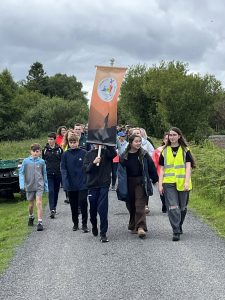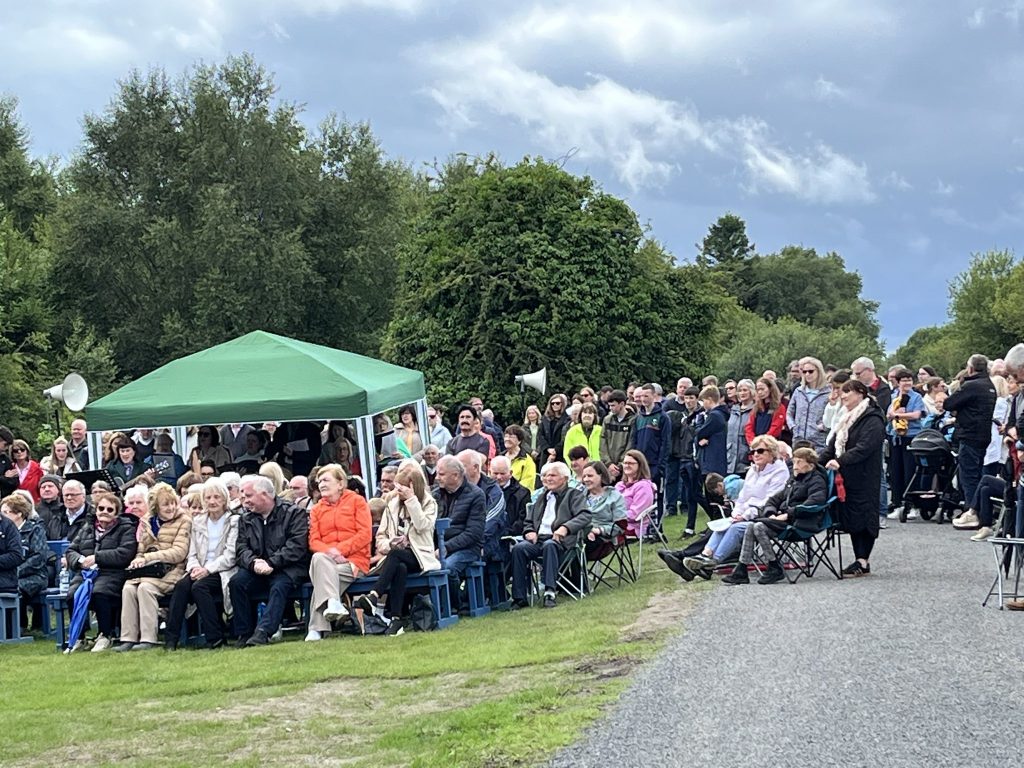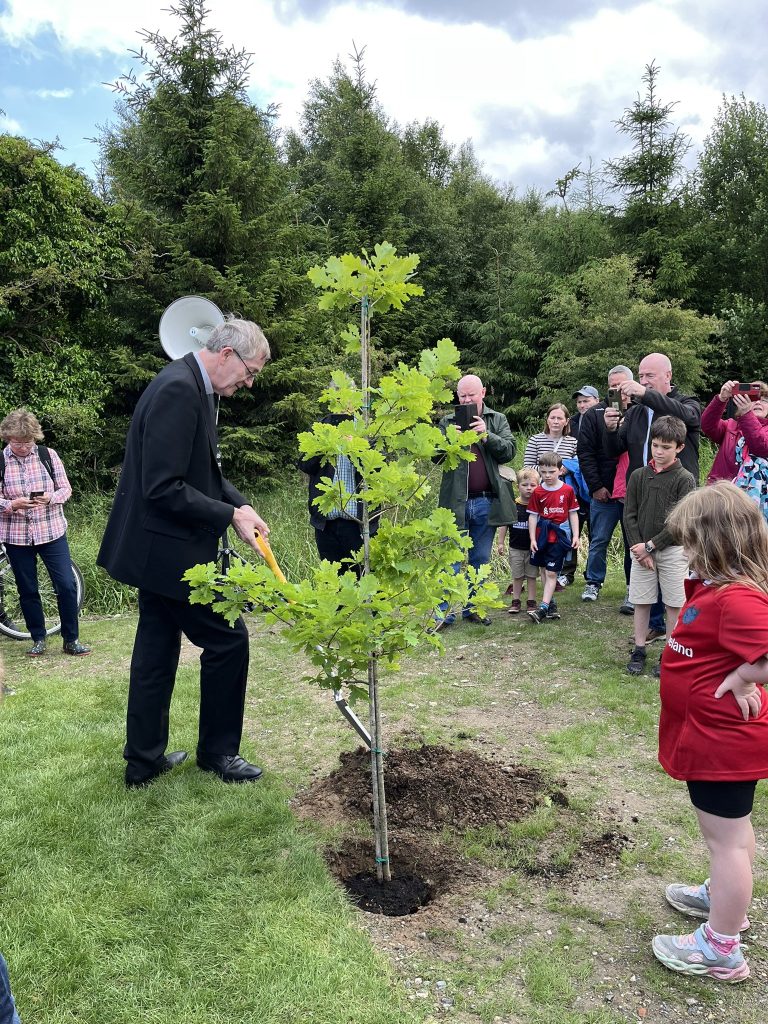Trinity Sunday – Year C: 15.06.25
2.00pm Mass – Penal Mass Rock, Ballyteague
Introduction:
In ainm an Athar agus an Mhic agus an Spioraid Naoimh. This is the prayer we know best that enters into the Trinity. A prayer recited at this very spot, most likely in Irish or in Latin, certainly not in English at the Priests Corner, in Penal Days. Prayed perhaps hurriedly for fear of the red coats or the notorious priest hunters.
Allen Church is dedicated to the Holy Trinity, so it seemed eminently sensible that this historic celebration at the Mass Rock here in Ballyteague should take place today, on Trinity Sunday.
We are standing on sacred ground, where some of my predecessors Mark Forstall, James Gallagher and James Keeffe would have offered Mass during Penal times. And before that, on the path Patrick and Brigid walked to visit Erc, Bishop of Lullymore and Slane. Indeed his well is on our farm at home.
The Trinity is who God really is: a real, personal, wise and loving God. And because through the Trinity he has revealed to us who he is, we can really speak to him and love him. He does that best through the celebration of his life, death and resurrection, we know as the Mass.
The same Mass that was celebrated on this Mass Rock over 300 years ago in Penal times. We come this afternoon as Pilgrims of Hope, who recall a dark time in our history, a time of persecution. Here at the Priests Corner the faithful gathered with their shepherd, and we do so once again this day. We begin as they did then, by praying for His love and mercy …
- Is tusa Tobar na Trócaire – you are the wellspring of mercy: A Thiarna, déan trócaire
- Is tusa Slí na Fírinne – you are the way of Truth: A Chríost, déan trócaire
- Bí linn i gconaí, ós ár gcomhair amach – be with us always, showing us the way. A Thiarna, déan Trócaire
Homily:
The Leaving Cert History Paper was sat last Wednesday. While the period of the Penal Laws is not examined, as the field of study under examination was ‘Later Modern History’ from 1815-1993, Catholic Emancipation came up on the Ordinary Level History paper. The contribution of Daniel O’Connell, Cardinal Paul Cullen and Mother Mary Aikenhead featured among the questions. The impact of An Gorta Mhór, the Great Famine was asked in the Higher Level paper. In order to understand An Gorta Mhór or Catholic Emancipation, we have got to have some appreciation of the Penal Laws.
The following penned by a Protestant poet reads:
“Oh! Weep those days – the penal days
When Ireland hopelessly complained.
Oh! Weep those days – the penal days
When godless persecution reigned.
They bribed the flock, they bribed the son
To sell the priest and rob the sire.
Their dogs were taught alike to run
Upon the scent of wolf and friar”[1].
It is said that in 1743 the bounty on the head of a bishop stood at £150, £50 for a priest and £20 “for the discovery of persons, who being in the possession of a certain amount of property, had nevertheless been guilty of entertaining or concealing a priest”[2]. Our diocesan historian Comerford and others refers to several bishops who were forced to seek refuge in the Bog of Allen, among them Bishop Mark Forstall (1676–1683); Bishop James Gallagher (1737-1751) and Bishop James Keeffe (1751-1787). There were of course other Bishops in that period, their connection to this place is a little harder to establish: Edward Wesley (1683); John Dempsey (1694); Edward Murphy (1715); Bernard Dunne (1724) and Stephen Dowdall (1733) who in time was succeeded by man, transferred from Raphoe, James Gallagher.
We are not the first in recent times to walk, pray or indeed celebrate Mass at this Priests Corner here at Ballyteague. Back on July 26th 1987 and then again in August 1996, Bishop Larry Ryan came here to remember his predecessors. I noted the commemorative booklet for the 1987 Mass had a drawing of the famous Prosperous Crozier found in these parts in 1839 during turf cutting, dating from the late 9th to early 11th century. It was cared for, over many years in Clongowes before being loaned by the Jesuits to the National Museum in 2018. A keen reminder once again that we are indeed on holy ground.
A place of refuge for successive bishops during the lengthened period of the penal times. In a letter written after a visitation to these parts by the great JKL in 1823 he refers to “the wide and vast expanse of the Bog of Allen is, that it afforded, for nearly two centuries, a place of refuge to the apostolic men who have gone before me in preaching the faith and administering the sacraments to a people in every respect worthy of such pastors. The haunts and retreats frequented by the Bishops of Kildare in the times of persecution are still pointed out by aged inhabitants of these marshes with a sort of pride mingled with piety, and they say ‘There he administered confirmation; here he held an assembly of the clergy; on that hill he ordained some young priests, whom he sent to France, Spain or Italy; and we remember, or we heard, how he lived in yonder old walls in common with the young priests whom he prepared for the mission. He sometimes left us with a staff in his hands; and being absent months, we feared he would never return; but he always came back, until he closed his days amongst us’ ”[3].
On Trinity Sunday we gather to remember. To speak of the mystery of God as Trinity is to speak of a God who relates, who reaches out. As the writer Miroslav Volf writes “the Christian God is not a lonely God, but rather a communion of three persons … communion with this God is at once also communion with others who have entrusted themselves in faith to the same God”[4]. As our predecessors gathered here in a time of persecution, they too realized their God was not a lonely God, and they weren’t either. Christian hope is not some idle optimism, but something rooted in the belief that Christ has risen, as we say on Easter Sunday “Christ has truly Risen!”
On this ‘Day for Life’ let us find meaning in suffering and an understanding that those who sit by the bedside, those who hold the frail hand, those who allow the rosary beads to slip through the fingers of their loved one are giving hope to those who need it most. For some, there is a suffering that must be endured, it’s sometimes difficult to always understand it, no different than those who suffered through the Penal days in these parts. A life marked by suffering is one full of meaning, when it is lived with generosity and patience. May the Lord bless all of us this, as we keep the memory alive of those who once walked, prayed, knelt and offered Mass here.
Glory be to the Father, and to the Son and to the Holy Spirit, as it was in the beginning is now and ever shall be, world without end. Amen.
[1] Hayden, Augustine OFM, ‘Ireland’s Loyalty to the Mass’, Sophia Institute Press, 2023 pgs. 137-138
[2] ibid, pg. 158: quoting a text from a ‘Proclamation issued by the Privy Council in Dublin, 1743’
[3] Comerford, ‘History of the Dioceses of Kildare & Leighlin’, J. Duffy & Sons, Dublin, Vol. II, pg. 59
[4] Volf, Miroslav: ‘After Our Likeness; The Church as the Image of the Trinity’, Eerdmans, 1998, pg. 173.



